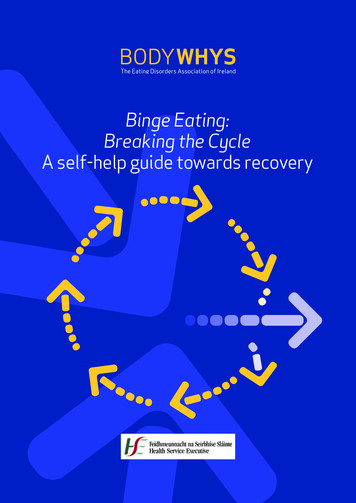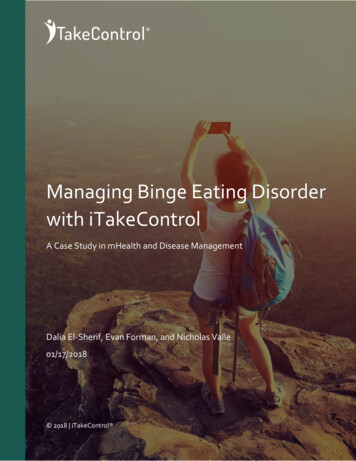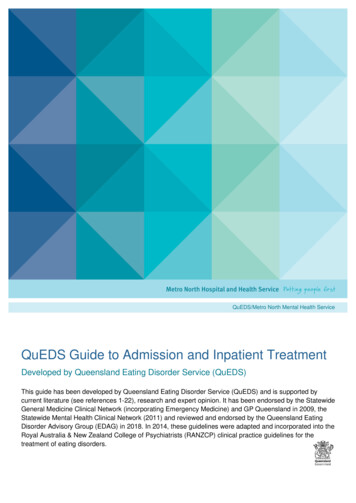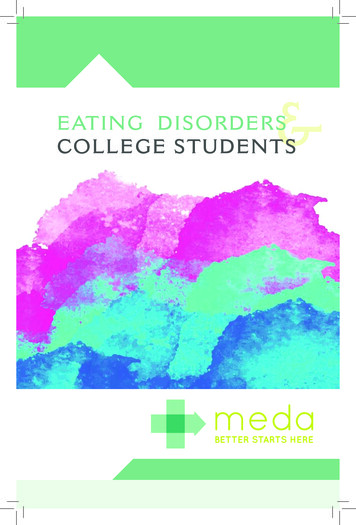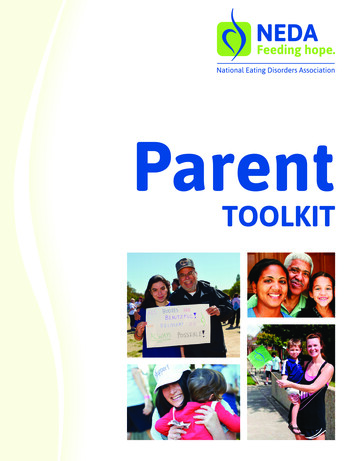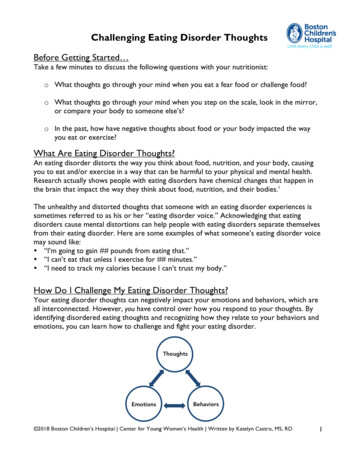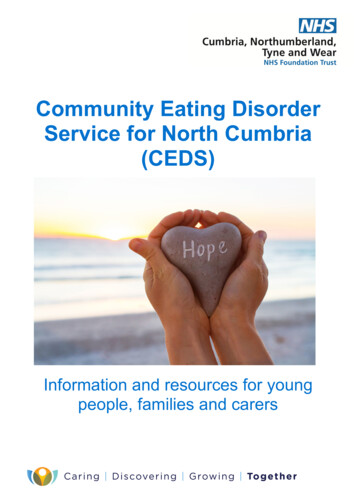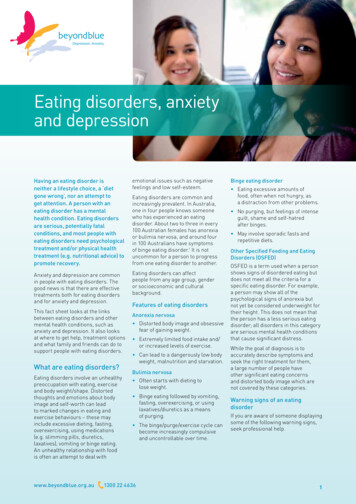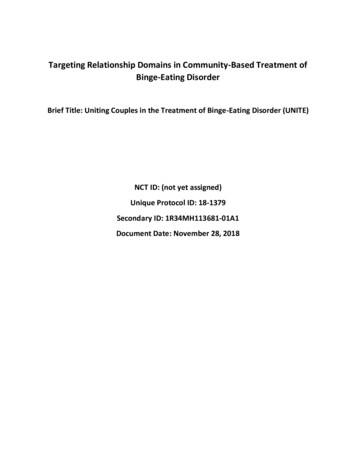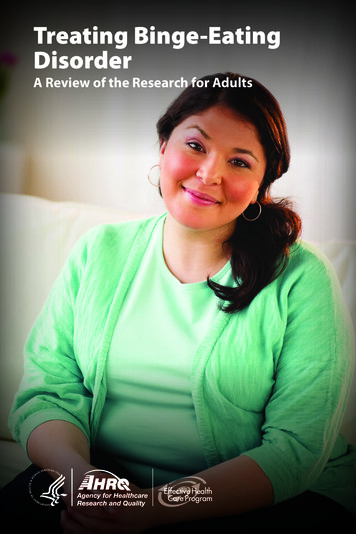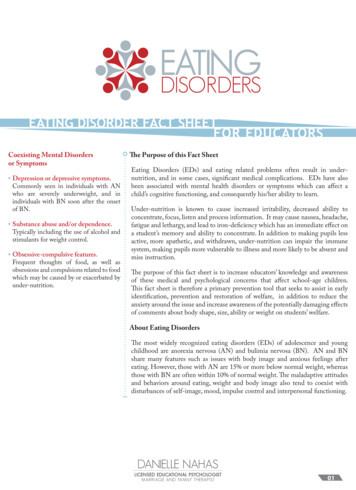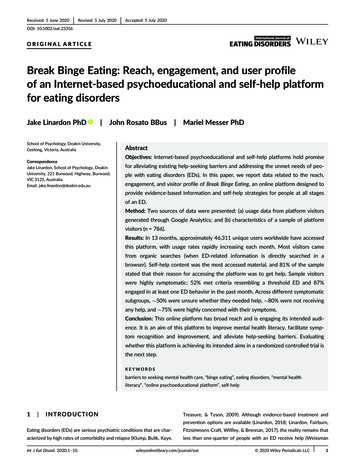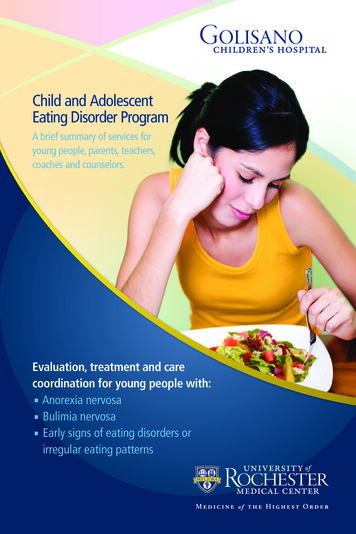
Transcription
Child and AdolescentEating Disorder ProgramA brief summary of services foryoung people, parents, teachers,coaches and counselors.Evaluation, treatment and carecoordination for young people with:Anorexia nervosaBulimia nervosa Early signs of eating disorders orirregular eating patterns.
Child and Adolescent Eating Disorder Program:Comprehensive, Proven Treatment Methods.More than 25 years ago, Strong Memorial Hospital began aprogram for children and adolescents with two common eatingdisorders – anorexia nervosa and bulimia nervosa. Today,this superior program based at Golisano Children’s Hospitalat the University of Rochester Medical Center in Rochester,OUR CHILD AND ADOLESCENT EATING DISORDER PROGRAM INCLUDESAN INTERDISCIPLINARY TEAM OF PROFESSIONALS SPECIALIZING IN: dolescent medicine – Physicians whoAare experts in adolescent medicine areresponsible for the overall care of patients,providing or supervising the medical andnutritional, as well as the individual, groupand family services on a daily basis. reative arts therapy – Provided by aClicensed, board-certified music therapistand music/art therapy interns, creative artstherapy allows patients to gain valuableself-awareness and express themselves sychiatry and psychology – ProfessionalsPspecializing in child and adolescent psychiatryand psychology provide mental healthevaluation and treatment for patients andtheir families, as needed.S ocial work – A certified social workerprovides services such as group and familytherapy, as well as coordinates care withinsurance companies and other providers.In addition, our social worker assists withdischarge planning.New York, serves young people in Upstate New York, reachingnorth to Watertown, south into Pennsylvania, west towardBuffalo and east to Albany.Our Eating Disorder Program Sets the Standard for ExcellenceOur nationally recognized team of adolescenthealth professionals comprehensively assessesyoung people at Golisano Children’s Hospitalat URMC – and develops and implementseffective, individualized treatment plans.F or over a quarter century, ourinterdisciplinary team has been treatingyoung people with eating disorders andtheir families using the biopsychosocialapproach, with excellent outcomes.Greater than 80% of patients admitted fortreatment of anorexia nervosa are still inrecovery 4 or more years after treatment.S ince 2005, we have been a core centerfor the New York State ComprehensiveCare Center for Eating Disorders ofWestern New York. We are looked toas a model for a statewide integrated,coordinated system of care. e have been involved in the developmentWof treatment guidelines for theAmerican Psychiatric Association andthe Society for Adolescent Medicine.Drawing on – and developing – the mostup-to-date, proven methods of treatment,Golisano Children’s Hospital helps youngpeople and their families move towardwellness and a healthy adulthood.in ways that may not be possible throughmore traditional therapies. Individual andgroup sessions are offered as part of theinpatient treatment plan. ursing – Registered nurses and nurseNpractitioners devoted to adolescent healthcare deliver nursing services tailored toeach young person’s individual needs.They carry out the nursing care plan eachday on the inpatient unit and also providea significant amount of the outpatienthealth care services. utrition – A registered dietitian withNspecial training and experience in adolescenteating disorders offers regular nutritioneducation and meal planning, with emphasison meal planning at home.S upportive meal therapy – Speciallytrained patient care technicians and otherstaff members on the Adolescent Unitsupervise meals during the hospital stay.This helps assure that patients experiencehealthy eating behaviors in a supportive,controlled environment with the goal ofmaking these behaviors life-long habits.T een life – Specialists in teen life helppatients develop their daily schedules andengage in therapeutic leisure activitiesthat focus on personal growth anddevelopment. They also coordinate tutoringand schoolwork, as well as fun groupactivities, while patients are in the hospital.
Both Outpatient and InpatientServices Are Family members, friends, teachers, coaches, clergy andother significant people in a young person’s life can be partof the solution to recovery and are included, as needed.Golisano Children’s Hospital works with families toidentify supportive behaviors within the family unit.Community resources that can enhance a young person’swell-being are also utilized.Since young people often show greater improvementwhen in a familiar environment surrounded by familyand friends, Golisano Children’s Hospital emphasizesoutpatient treatment. In fact, the majority of the childrenand adolescents we see annually are treated as outpatients.Before a treatment plan is put in place, patients receivea full health evaluation that includes: detailed medical history, physical examination and laboratoryAtests that help provide a full diagnostic picture An in-depth evaluation of nutritional intake and requirements assessment of individual and family strengths, and any areasAnof special sensitivity or vulnerability Determination of coping styles, mood, anxiety and sources of stressDuring family-centered outpatient treatment, Golisano Children’s Hospital offers comprehensive,coordinated care that includes medical monitoring and treatment, education about the illnessand methods of treatment, nutritional counseling, support group information and outpatient grouptherapy. Mental health therapy for the individual and family, which is fundamental to the treatmentof eating disorders, is provided. Connections to specialists within the community are also facilitated.InpatientIf a young person is severely malnourished, has chemical or fluid imbalances, is unable to controldieting or vomiting or becomes medically unstable, hospitalization may be required. Inpatients areadmitted to Golisano Children’s Hospital, the only dedicated pediatric Adolescent Unit inNew York State north of New York City – and are closely monitored and moved incrementallytoward taking greater responsibility for their own health. Tutoring and contact with school ismaintained throughout the hospitalization so that patients keep up with academics. We alsobuild strong relationships with parents, who are actively involved in their child’s treatment fromadmission to discharge from the hospital. This entire process helps lead to a successful outcome.The full range of comprehensive,coordinated and integratedpediatric eating disorder servicesavailable has made GolisanoChildren’s Hospital the onlypediatric unit designated by theNew York State Department ofHealth as a Comprehensive CareCenter for Eating Disorders.
Be Sure to Ask Questions hat are some of the symptoms ofWan eating disorder?Having a family member with an eating disorder can result inall sorts of feelings – as well as ups and downs. Our programat Golisano Children’s Hospital helps families move throughthese difficult times with a focus on a positive, healthy future.Never hesitate to ask a question or to seek additional support,guidance or reassurance. Our eating disorders team is here for YOU.You can turn to the Child and Adolescent EatingDisorder Program at Golisano Children’s Hospitalfor answers to questions that are frequentlyasked by young people, parents, teachers,coaches and counselors including:How do you determine whether or not a young person has an eating disorder?The signs of an eating disorder can be subtle at first.Young people and their families should come to ourfacility as soon as they have any concern about a familymember’s eating and exercising patterns, even justan inkling that something might be wrong. Theearlier an eating problem – even if it’s not yeta full-blown eating disorder – is recognizedand treatment begins, the better.How serious is an eating disorder?An eating disorder is potentially life threatening.Eating disorders have one of the highestdeath rates of any mental health condition.Intense dieting or preoccupation with foodHiding/discarding foodCounting calories, grams of fat in the dietRapid or excessive weight lossFeeling tired, cold and weakLack of energyCold and blue hands and feetDizziness or faintingHair lossSlow heart rateAbsent or irregular menstruationExcessive facial/body hairBinge eatingVomiting or taking laxativesSwollen salivary glandsCompulsive or excessive exerciseSelf-worth determined by weight or shapeSome of these may also be symptoms of other illnesses.That’s why a full evaluation at Golisano Children’sHospital is so important. Which young people are most at risk? dolescent females who are high-achievingAand perfectionistic Young people who have a low self-worth or are depressed, anxious or sadY outh involved in athletic or artistic endeavors that emphasize thinness(e.g., running, ballet or gymnastics) Teens dealing with family stress, transition or loss Children and adolescents who are teased about their weight
Whoare patients of the Golisano Children’s HospitalChild and Adolescent Eating Disorder Program?The Golisano Children’s Hospital program is designed for young people from 10 to 21years of age. Although most patients with anorexia or bulimia are females, we also treatmales with these eating disorders. Every socio-economic level is affected, though youngpeople in middle- to upper-income families are particularly susceptible. We serve allpatients, regardless of gender, race, socio-economic or other factors.Is the treatment for an eating disorder offered right at Golisano Children’s Hospital?Yes. When a child or adolescent can be helped on an outpatient basis, care is offeredat our outpatient clinic. Most young people are helped in this way. Behavioral healthresources within the community and the patient’s personal physician are relied on as well. If a young person’s medical condition requires hospitalization, she or he is treated by oursame team of specialist physicians, nurse practitioners and nurses within the pediatricAdolescent Unit at Golisano Children’s Hospital.What is the length of time it might take to attain a healthy eating/living pattern?Because anorexia and bulimia are complex disorders, there is considerable individualvariation in how long it takes to become healthy. A young person might be in treatmentfrom a few months to 2 years or more. The standard inpatient treatment protocol is 17 days,but the length of stay for hospitalized patients depends on a number of factors. At times,inpatients need to take part in our affiliated residential treatment or partial hospitalizationprogram prior to being discharged home for good. At Golisano Children’s Hospital,treatment plans are designed to meet the specific needs of each patient and family. What are the success rates?Success is proven. Based on follow-up studies, more than 80% of our inpatient eatingdisorder patients eventually attain and maintain a healthy eating pattern. There issubstantial evidence that Golisano Children’s Hospital outpatients also recover in thevast majority of cases.Young People or Their Families MayWish to Consult the Following Organizationsfor Information and SupportCOMPREHENSIVE SERVICES:CHILD AND ADOLESCENT EATING DISORDER PROGRAMGOLISANO CHILDREN’S HOSPITALUNIVERSITY OF ROCHESTER MEDICAL CENTER601 Elmwood Avenue, Box 690 Rochester, New York 14642585-275-2964 585-242-9733 ION:NEW YORK STATE COMPREHENSIVE CARECENTERS FOR EATING DISORDERSEating Disorders Recovery Center of Western New York800-700-4573 (toll free)www.nyeatingdisorders.orgNATIONAL EATING DISORDERS ASSOCIATION603 Stewart Street, Suite 803 Seattle, Washington 98101206-382-3587www.nationaleatingdisorders.org
Some Recommended Readings:Our Team: Help Your Teenager Beatan Eating DisorderJames Lock, MD, PhD; Daniel Le Grange, PhDThe Child and Adolescent Eating Disorder Program resides inthe Division of Adolescent Medicine, Department of Pediatrics,at Golisano Children’s Hospital at URMC.Surviving an Eating Disorder:Strategies for Family and FriendsMichele Siegel, PhD; Judith Brisman, PhD;Margot Weinshel, MSW.S kills-based Learning for Caringfor a Loved One with an EatingDisorder: The New Maudsley MethodJanet Treasure, MDThe strengths of the Child and Adolescent Eating DisorderProgram at Golisano Children’s Hospital include:An asset-based, family-centered, community-focused approachA thorough patient evaluationA comprehensive, evidence-based treatment planA nationally recognized interdisciplinary, professional teamOn-site medical and nutritional monitoring Ongoing care coordination by our eating disorders staff inconjunction with services provided by the young person’sprimary care physician and other professionals in thepatient’s local communityThe vast majority of young people withan eating disorder who seek help atGolisano Children’s Hospital recover.Our professionals work closely with colleagues across New York State to identify and facilitatereferral to appropriate treatment options and settings for patients. These options includethe only residential treatment facility for children and adolescents with eating disordersat Harmony Place in Rochester, as well as the only partial hospitalization program in theFinger Lakes Region at The Healing Connection in Fairport.DirectorRichard Kreipe, MD, FAAP, FSAM, FAED, the founding Director of the Child and AdolescentEating Disorder Program, is a board-certified pediatrician and adolescent medicine specialist, aswell as a Fellow of the Academy for Eating Disorders. His professional focus for the last 30 yearshas been on pediatric eating disorders, having published numerous research studies, articles, bookchapters, position papers and reviews on the topic. Dr. Kreipe is a consultant to the AmericanPsychiatric Association regarding diagnostic criteria for eating disorders in young people. He is thefounding Medical Director of the Western New York Comprehensive Care Center for Eating Disorders,which forms a coordinated, integrated network of care across the full range of services and settingsrequired for the treatment of eating disorders. In addition, Dr. Kreipe devotes much time to in-personand web-based continuing education of professionals to encourage earlier recognition and treatment ofeating disorders, as well as community-based prevention efforts.PhysiciansMeera Beharry, MDMandy Coles, MDCheryl Kodjo, MD, MPHO.J. Sahler, MDSusan “Shellie” Yussman, MD, MPH.Please visit www.Golisano.URMC.edu/EatingDisorders for information aboutour additional team members.
FOR FURTHER INFORMATION OR TO REQUEST ACONSULTATION, PLEASE CONTACT:Child and Adolescent Eating Disorder ProgramGolisano Children’s HospitalUniversity of Rochester Medical Center601 Elmwood Avenue, Box 690 Rochester, New York 14642585-275-2964585-242-9733 (fax)www.Golisano.URMC.edu/EatingDisorders
Counting calories, grams of fat in the diet Rapid or excessive weight loss Feeling tired, cold and weak Lack of energythese difficult times with a focus on a positive, healthy future. Cold and blue hands and feet Dizziness or fainting Hair loss Slow heart rate Absent or irregular menstruation Excessive facial/body hair
